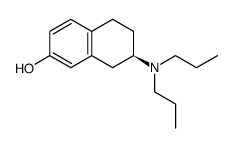R(+)-7-HYDROXY-2-DIPROPYLAMINO TETRALIN&

R(+)-7-HYDROXY-2-DIPROPYLAMINO TETRALIN& structure
|
Common Name | R(+)-7-HYDROXY-2-DIPROPYLAMINO TETRALIN& | ||
|---|---|---|---|---|
| CAS Number | 82730-72-1 | Molecular Weight | 247.37600 | |
| Density | N/A | Boiling Point | N/A | |
| Molecular Formula | C16H25NO | Melting Point | N/A | |
| MSDS | USA | Flash Point | N/A | |
|
Chemical genetics reveals a complex functional ground state of neural stem cells.
Nat. Chem. Biol. 3(5) , 268-273, (2007) The identification of self-renewing and multipotent neural stem cells (NSCs) in the mammalian brain holds promise for the treatment of neurological diseases and has yielded new insight into brain cancer. However, the complete repertoire of signaling pathways ... |
|
|
Genetic mapping of targets mediating differential chemical phenotypes in Plasmodium falciparum.
Nat. Chem. Biol. 5 , 765-71, (2009) Studies of gene function and molecular mechanisms in Plasmodium falciparum are hampered by difficulties in characterizing and measuring phenotypic differences between individual parasites. We screened seven parasite lines for differences in responses to 1,279... |
|
|
Role of dopamine D2 and D3 receptors in mediating the U-50,488H discriminative cue: comparison with methamphetamine and cocaine.
Addict. Biol. 17(6) , 949-55, (2012) Substitutions of the dopamine D(2) or D(3) receptor agonists for the discriminative stimulus effect induced by U-50,488H, methamphetamine (METH) and cocaine in rats were examined. The D(2) receptor agonist R-propylnorapomorphine [(-)-NPA] failed to substitute... |
|
|
Stimulation of dopamine D2/D3 but not D1 receptors in the central amygdala decreases cocaine-seeking behavior.
Behav. Brain Res. 214(2) , 386-94, (2010) Alterations in dopamine output within the various subnuclei of the amygdala have previously been implicated in cocaine reinforcement, as well as cocaine-seeking behavior. To elucidate the potential for increased stimulation of D1- and D2-like receptors (D1Rs ... |
|
|
Role of the neurokinin-1 receptors in ejaculation in anesthetized rats.
J. Sex. Med. 6(1) , 126-34, (2009) Several lines of evidence indicate a role for substance P in the control of ejaculation, although its mode of action needs to be clarified.The effects and sites of action of a selective antagonist for the substance P-preferred receptor (neurokinin-1 receptor ... |
|
|
The discriminative stimulus effects of dopamine D2- and D3-preferring agonists in rats.
Psychopharmacology 203(2) , 317-27, (2009) Previous research has found the stimulus effects of dopamine D2- and D3-preferring agonists difficult to distinguish in drug discrimination studies. Antagonism studies suggest that the stimulus effects of both types of agonists may be mediated primarily throu... |
|
|
Selective agonists for dopamine/neurotensin receptor heterodimers.
ChemMedChem 7(3) , 509-14, (2012) The neuromodulatory peptide neurotensin has been described to functionally interact with dopaminergic pathways of the human brain. We employed radioligand binding studies to investigate the physical interaction between co-expressed dopamine D(2L) or D₃ and ne... |
|
|
Cocaine self-administration leads to alterations in temporal responses to cocaine challenge in limbic and motor circuitry.
Eur. J. Neurosci. 34(5) , 800-15, (2011) Chronic use of cocaine is associated with lasting alterations in brain metabolism, circuitry, and receptor properties. We used neuroimaging with pharmacological magnetic resonance imaging to assess alterations in response to cocaine (0.5 mg/kg) in animals tra... |
|
|
Blockade of the acquisition, but not expression, of associative learning by pre-session intra-amygdala R(+) 7-OH-DPAT.
Psychopharmacology 203(1) , 161-73, (2009) Two issues were addressed regarding the effects of amygdala dopamine manipulations on associative learning: first, an apparent contradiction between the effects of post- vs. pre-session dopaminergic manipulations and second, the ability of dopaminergic infusi... |
|
|
Dopamine D3 receptor-preferring agonists increase dendrite arborization of mesencephalic dopaminergic neurons via extracellular signal-regulated kinase phosphorylation.
Eur. J. Neurosci. 28(7) , 1231-40, (2008) Clinical improvements in Parkinson's disease produced by dopamine D3 receptor-preferring agonists have been related to their neuroprotective actions and, more recently, to their neuroregenerative properties. However, it is unclear whether dopamine agonists pr... |